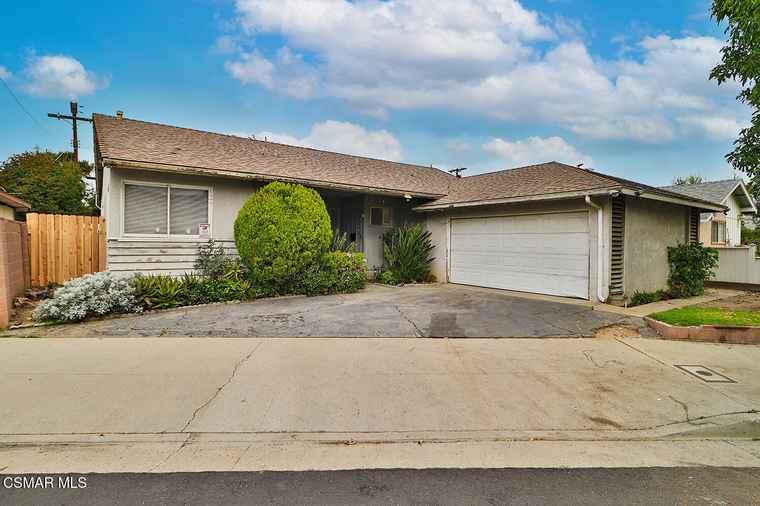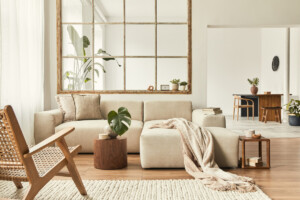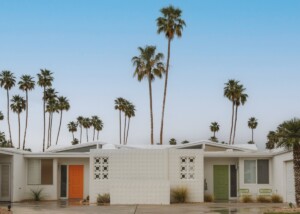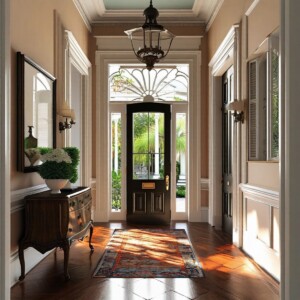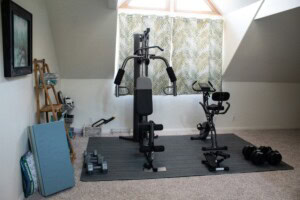Experts share how to bring that old school 90s decor trends into today’s spaces with neutral tones, clean lines, and functional design staples.
The 1990s and 2000s marked a shift toward simplicity, with interiors favoring open layouts, neutral palettes, and an emphasis on livability. Think white or beige walls, functional shaker-style cabinets, and subway tile backsplashes that add just enough detail without overwhelming the space.
This era was all about practicality with a polished edge—granite and quartz countertops, clean-lined furniture, and finishes that prioritized both form and function. Whether you’re updating a suburban split-level house in Denver or refreshing a minimalist apartment in Los Angeles, there’s still a lot to love (and keep) from this era. We asked design experts to share how they’re reimagining the best of 1990s and 2000s design in modern homes—bringing timeless ideas forward with a refined touch.

1. Open up your space with a modern take on the open floor plan
Mark O’Krafka from Team O’Krafka says, “One of our favorite design elements from the 1990s–2000s is the open-concept floor plan. It’s a layout that still resonates today, especially when paired with modern lighting, neutral tones, and layered textures. We also appreciate how stainless steel appliances and clean-lined cabinetry from that era have evolved into timeless staples with a sleeker, more sophisticated twist.”
2. Use floral wallpaper and brass for a fresh twist on tradition
“Floral wallpaper was a mainstay of 1990s interior decor and added a soft, feminine touch to homes of that era,” shares Elizabeth & Lindsay, Dwell October. “We love using bold floral wallpaper to add personality to small spaces, such as powder bathrooms and guest bedrooms. We often pair it with wainscoting or shiplap paneling for a modern twist.”
Polished brass plumbing fixtures were all the rage in the 1990s. We love the warmth that gold and brass finishes bring to a space, and we often incorporate them into our designs today. Our trick is to mix in another complementary metal—like matte black or chrome—to give the space a more layered, updated look.”
3. Highlighting 1990s-inspired layouts with comfort and functionality
“Minimal in Design leans into incorporating elements influenced by the 1990s and 2000s—specifically a neutral palette, open-concept living, and a focus on comfort and functionality.” Laura Howett from Minimal in Design says, “We’re big on the open floor plan concept and design our furniture aesthetic and layout with that in mind. The 1990s and 2000s really made a lasting mark with this design shift.”
4. Let in the light and define cozy, flexible spaces
“What I appreciate about 1990s and early 2000s design is how unapologetically practical it was,” mentions Jimmy Welch, President of the The Jimmy Welch Team. “It focused on comfort and livability—spaces people actually wanted to spend time in. One feature I’ve always liked is the dedicated family room.
Back then, it wasn’t all wide-open everything—there were still boundaries that created cozy, functional spaces. Today, we’re seeing a return to that idea with flex rooms and quiet corners. I’d also bring back the emphasis on natural light and big, simple windows. Instead of heavy drapes, it was all about letting the light in. Now we update that with energy-efficient designs and cleaner window treatments, but the goal is still the same—a bright, welcoming space. The ’90s style wasn’t overly curated, and that authenticity still resonates.”
5. Mix ’90s minimalism with modern, sustainable design
Justin Landis, Founder of Justin Landis Group, recommends, “I still love incorporating those modern elements—like stainless steel appliances and streamlined layouts—into homes today, often blending them with natural textures and lighter colors to keep spaces feeling open and airy. Open-concept living continues to work well, especially when paired with smart tech, flexible layouts, and sustainable materials. That mix of nostalgia and practicality makes a space feel timeless and livable.”

6. Layer earthy neutrals with texture and modern contrast
Nitya Seth, Interior Designer at Nityanamya, suggests, “I still enjoy working with earthy neutral palettes—beiges, taupes, and warm grays—layered with textured decor to add depth without feeling dated. There’s real harmony between ’90s minimalism and today’s preference for functional, uncluttered spaces. I also love incorporating glossy finishes and futuristic shapes from the 2000s to create visual contrast, using curved furniture and metallic details in moderation. When vintage-inspired elements are combined thoughtfully with modern design, the result is a space that feels both updated and authentic.”
7. Modernize 1990s design staples with subtle upgrades
“You know what? I’ll never let go of 1990s–2000s design. Its simplicity—open spaces, clean lines, and no-fuss style—still feels fresh today. Sure, not everything from back then needs a comeback (looking at you, sponge-painted walls), but a lot of it still works. That era focused on comfort and livability, which we all still want.,” informs Magda Callery, Interior Designer at Style by Magda. “By softening the lines, updating materials, and adding texture, we’re not starting over—we’re just modernizing a good idea. Design is all about mixing the old with the new. And if that includes a little ’90s chic? I’m in—just no blow-up chairs, please.”
Magda’s favorite ’90s-inspired design trends, but updated for today:
- Beige-on-beige, but with texture: Layered neutrals feel calm, not dull, when paired with wood, natural stone, and tactile fabrics.
- Open floor plans, with intention: Keep the flow, but define spaces with rugs, lighting, or bold florals.
- Wood and stainless steel: Balance sleek metal with warm, rustic finishes for a grounded, modern look.
- Low-key built-ins: Clean-lined cabinetry and subtle storage let materials and craftsmanship shine.
8. Work with what you’ve got—just give it new life
“I grew up during the rise of HGTV and was heavily influenced by designers like Michael Payne, who blended masculine and feminine styles with a focus on functionality. I still remember how he used stainless steel appliances to make kitchens feel sleek yet livable—that stuck with me.” Melody Stevens, Owner of Design on a Dime Interiors continues, “What I appreciated about 1990s and early 2000s design was the shift toward open floor plans and earthy palettes that made homes feel calm and intentional. Black granite, maple cabinets, and stainless steel created a polished, thoughtful look.
Even though I wasn’t designing for clients yet, that era shaped how I think about balance in design—mixing timeless structure with fresh, functional updates. I still walk into ’90s homes and think, ‘We can work with this.’ The bones are solid—we just give it new life.”
9. Balance minimalism with warmth and intention
“I got my start managing renovations on properties I invested in, and now I run a GC firm here in NYC. What I still respect about late ’90s and early 2000s design is the simplicity—it was all about clean lines, open layouts, and function over fluff,” says Adam Hicks, CEO of CooperBuild.
“A lot of apartments and brownstones we work on still have bones from that era, and when done right, those open floor plans still hold up. I’ve been bringing back earth tones—warm beiges, taupes, soft browns—but using better materials and textures to give them depth. Stainless steel? Still a classic when balanced with wood or stone—it gives you that durable, unfussy look New Yorkers appreciate. The key is taking the calm, minimal vibe from back then and updating it with craftsmanship and detail. It complements modern living without feeling too sterile or staged.”
10. Why wallpaper is back—and how to use it to transform a room
Andrea Thompson, Owner and Founder of Drea Design Services, claims, The early 2000s were a time when we collectively turned our backs on wallpaper, considering it dated and out of step with newer design trends. Instead, designers and homeowners embraced bare walls, opting for DIY techniques like blotting paint with sea sponges and rags, using stencils and stamps, or even sandpapering for an aged look.
I think it’s fair to say those trends are—almost—completely gone, replaced by a renewed love for wallpaper and its endless creative possibilities, bold designs, and mural-inspired wow factor. Wallpaper is king again, and my clients and I are all for it. Whether it’s a statement wall or an entire room, the right wallpaper can define a space like no other single element.”




